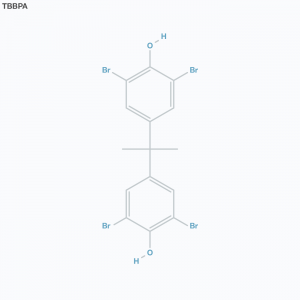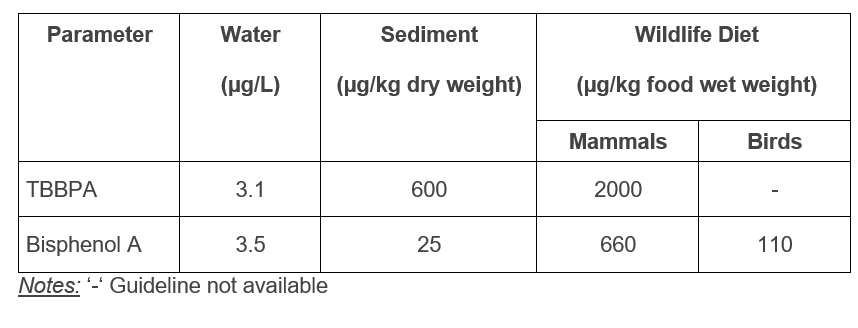SedimentTBBPA (µg/kg dry weight)
|
MusselsTBBPA (µg/kg wet weight)
|
|
|---|---|---|
|
|
North |
|
| South |
What is it?
Tetrabromobisphenol A (TBBPA) is a brominated flame retardant (BFR) used in flame-retarded epoxy and polycarbonate resins and is currently the highest selling brominated flame retardant globally. Resins containing TBBPA have wide-ranging applications, including communications and electronics equipment, automotive parts, and appliances.1 TBBPA is not known to have been manufactured in Canada.

How does it get into the ocean?
The major pathways by which BFRs enter the marine environment are likely via leaching from finished products into wastewater systems and via landfill runoff.1,2
TBBPA has relatively low solubility in water, and therefore, is likely to bind to organic matter in sediments. TBBPA may also accumulate in the lipids of marine organisms.1
Is it a problem?
Like other BFRs, TBBPA is persistent in the environment and can accumulate in organisms (bioaccumulative). It has even been detected in the remote Arctic in sediments, plants, fish, and birds.3
FACT: Bisphenol A, a hormone mimic that has received much public attention due to its presence in plastic water bottles, is a breakdown product of TBBPA.
As a group, brominated flame retardants are known to have toxic effects in terrestrial and aquatic organisms, with TBBPA known to have adverse effects on survival, reproduction, and development.1 In bluegill sunfish and rainbow trout, exposure to TBBPA resulted in irritation, twitching, and erratic swimming, while in fathead minnow, exposure resulted in reduced growth.4 Zebrafish embryos exposed to TBBPA experienced swelling, hemorrhage, decreased heart rate, tail malformations, and death.5
One of the degradation products of TBBPA in the environment is bisphenol A. Like TBBPA, bisphenol A is persistent and bioaccumulative, and is toxic to both aquatic and terrestrial organisms.1 It can disrupt hormones, which means that it impacts systems that regulate everything from embryonic development and the formation of reproductive glands to growth and digestion.6,7
What is being done?
TBBPA is still used to manufacture products in Canada, and its use is not yet regulated. Canadian federal environmental quality guidelines (FEQGs) have been developed for TBBPA and bisphenol A for water (protective of aquatic life), sediment (protective of sediment-dwelling organisms and pelagic animals that bioaccumulate TBBPA from sediments), and tissues of aquatic biota (protective of mammals and birds consuming aquatic biota).8,9 FEQGs for TBBPA and bisphenol A are listed in Table 1.
Table 1. Federal Environmental Quality Guidelines for TBBPA 8 and Bisphenol A 9

What can you do?
As individuals and organizations, we can:
- Learn more about TBBPA and other brominated flame retardants using the resource links below.
- Recycle and dispose of waste responsibly and according to local guidelines.
- Avoid using products that contain TBBPA and other contaminants of concern. The US EPA’s Safer Choice program identifies products that are safer for humans and the environment and can be used as a reference to check product ingredients. 10,11 The Green Science Policy Institute also provides information regarding consumer choices. 12
More information?
1 Environment and Climate Change Canada (ECCC) and Health Canada. 2013. Screening Assessment Report. Available at: http://www.ec.gc.ca/ese-ees/default.asp?lang=En&n=BEE093E4-1\
2 Morris S, Allchin CR, Zegers, BM, Haftka JJH, Boon JP, Belpaire C, Leonards PEG, van Leeuwen SPJ, de Boer J. 2004. Distribution and fate of HBCD and TBBPA brominated flame retardants in North Sea estuaries and aquatic food webs. Environmental Science and Technology 38: 5497-5504.
3 de Wit CA, Herzke D, Vorkamp K. 2010. Brominated flame retardants in the Arctic environment—trends and new candidates. Science of the Total Environment. 408(15): 2885-2918.
4 Darnerud PO. 2003. Toxic effects of brominated flame retardants in man and in wildlife. Environment International 29: 841-853.
5 McCormick JM, Paiva MS, Häggblom MM, Cooper KR, White LA. 2010. Embryonic exposure to tetrabromobisphenol A and its metabolites, bisphenol A and tetrabromobisphenol A dimethyl ether disrupts normal zebrafish (Danio rerio) development and matrix metalloproteinase expression. Aquatic Toxicology 100: 255-262.
6 Flint S, Markle T, Thompson S, Wallace E. 2012. Bisphenol A exposure, effects, and policy: A wildlife perspective. Journal of Environmental Management 104: 19-34.
7 Kang JH, Aasi D, Katayama Y. 2007. Bisphenol A in the aquatic environment and its endocrine-disruptive effects on aquatic organisms. Critical Reviews in Toxicology 37: 607-625.
8 Environment and Climate Change Canada (ECCC). 2016. Canadian Environmental Protection Act, 1999 Federal Environmental Quality Guidelines: Tetrabromobisphenol A (TBBPA). Available at: Environment and Climate Change Canada – Federal Environmental Quality Guidelines Tetrabromobisphenol A (TBBPA)
9 Environment and Climate Change Canada (ECCC). 2018. Canadian Environmental Protection Act, 1999 Federal Environmental Quality Guidelines: Bisphenol A. Available at: https://www.canada.ca/en/environment-climate-change/services/evaluating-existing-substances/federal-environmental-quality-guidelines-bisphenol-a.html
10 United States Environmental Protection Agency (US EPA). 2018. Safer Choice. Available at: https://www.epa.gov/saferchoice
11 United States Environmental Protection Agency (US EPA). 2014. Flame Retardant Alternatives for Hexabromocyclododecane (HBCD). Available at: https://www.epa.gov/sites/production/files/2014-06/documents/hbcd_report.pdf
12 Green Science Policy Institute. 2017. Flame Retardants. Available at: http://www.sixclasses.org/videos/flame-retardants
